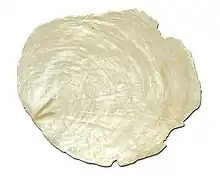| Windowpane oyster | |
|---|---|
 | |
| A cleaned shell of the capiz ready for processing, with the V-shaped ligament ridge showing | |
| Scientific classification | |
| Domain: | Eukaryota |
| Kingdom: | Animalia |
| Phylum: | Mollusca |
| Class: | Bivalvia |
| Order: | Pectinida |
| Family: | Placunidae |
| Genus: | Placuna |
| Species: | P. placenta |
| Binomial name | |
| Placuna placenta | |
The windowpane oyster (Placuna placenta) is a bivalve marine mollusk in the family of Placunidae.[1] They are edible, but valued more for their shells (and the rather small pearls). The shells have been used for thousands of years as a glass substitute because of their durability and translucence. More recently, they have been used in the manufacture of decorative items such as chandeliers and lampshades; in this use, the shell is known as capiz shell (kapis).[2] Capiz shells are also used as raw materials for glue, chalk and varnish.
Distribution extends from the shallows of the Gulf of Aden to around the Philippines, where it is abundant in the eponymous province of Capiz. The mollusks are found in muddy or sandy shores, in bays, coves and lagoons to a depth of about 100 m (330 ft).
Populations have been in decline because of destructive methods of fishing and gathering such as trawling, dredging, blast fishing and surface-supplied diving. In the Philippines, fisheries are now regulated through permits, quotas, size limits and protected habitats. In spite of this, resources continue to be depleted.[3]
The nearly flat shells of the capiz can grow to over 150 mm (5.9 in) in diameter, reaching maturity between 70 and 100 mm (2.8 and 3.9 in). The shell is secured by a V-shaped ligament. Males and females are distinguished by the color of the gonads. Fertilization is external and larvae are free-swimming like plankton for 14 days or attached to surfaces via byssal thread during metamorphosis, eventually settling on the bottom.[4] They consume plankton filtered from the water passing through their slightly opened shell; the shell closes if the bivalve is above water during low tide.[2]
The capiz industry of Samal, Philippines
Aside from being abundant in the province of Capiz, capiz shells are also abundant in the island of Samal in the Philippines, where 500 tons of capiz shells are harvested every other year.
The capiz shells found around the island are harvested and transformed into various decorative products. As late as 2005, the residents of the island were trained to sustain the industry. However, the transfer of institutional knowledge to new generations to maintain the industry is in danger of being lost.[5]
 Capiz shell windows are an important icon in Philippine culture
Capiz shell windows are an important icon in Philippine culture A parol made with capiz shells for its panes
A parol made with capiz shells for its panes A decorative mobile at the Museo de San Pablo in San Pablo, Laguna, Philippines using capiz shells.
A decorative mobile at the Museo de San Pablo in San Pablo, Laguna, Philippines using capiz shells. Traditional windows with sliding panes made with capiz shells at the convent of Calasiao Church in the Philippines
Traditional windows with sliding panes made with capiz shells at the convent of Calasiao Church in the Philippines
See also
References
- ↑ "Placuna placenta (Linnaeus, 1758)". www.gbif.org. Retrieved 8 October 2021.
- 1 2 "Fisheries and aquaculture of window-pane shells". Malacological Society of London. Retrieved on 2011-10-23.
- ↑ Park, Monica. "Capiz Shells and Their Uses". Retrieved 14 September 2015.
- ↑ "Bivalves". Retrieved on 2011-10-24.
- ↑ Gonzaga, Robert (31 May 2012). "After Jessica Sanchez, Samal's capiz products now in limelight". business.inquirer.net. Retrieved 2019-12-09.